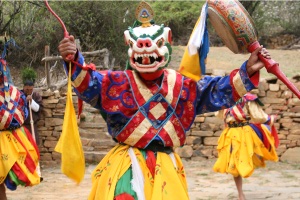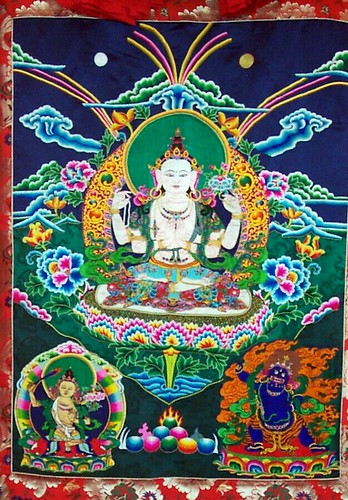
Mystery surrounds Bhutan's distant past, as priceless irretrievable documents were lost in fires and earthquakes. In the 8th century CE, Guru Rinpoche (Padmasambhava or second Buddha) made his legendary trip from Tibet to Bhutan on the back of a flying tigress to subdue the evil spirits who hindered Buddhism. And after defeating them, he blessed them as guardians of the doctrine. Introducing Tantric Buddhism to Bhutan. Taktsang or Tigers Nest in the Paro Valley is where he landed and remains one of most sacred places in Bhutan.
Guru Rinpoche (Precious Master) is the father of the Drukpa Kagyu school of Tantric Mahayana Buddhism practiced in Bhutan. Sgabdrung Ngawang Namgyal, a Tibetan lama of the Drukpa School, arrived in Bhutan in 1616. He introduced the present dual system of religious and secular government, creating and building the system of Dzongs through out Bhutan. Shabdrung unified the country, and established himself as the country's supreme leader and vested civil power in a high officer known as the Druk Desi. Religious affairs were charged to another leader, the Je Khenpo (Chief Abbot of Bhutan). For two centuries following Shabdrung's demise, civil wars intermittently broke out, and the regional penlops (governors) became increasingly more powerful. This ended when an assembly of representatives from the monastic community, civil servants and the people, elected the Penlop of Trongsa, Ugen Wangchuck, the First King of Bhutan in 1907. The monarchy has thrived ever since, and the present king, His Majesty Jigme Singye Wangchuck, fourth in line, commands an overwhelming support for his people.
The Royal Government of Bhutan recognizes that tourism is a world-wide phenomenon and an important means of achieving socioeconomic development particularly for developing countries like Bhutan. It also recognizes that tourism, in affording the opportunity to travel, can help in promoting understanding among peoples and building closer ties of friendship based on appreciation and respect for different cultures and lifestyles.
There are, however, problems associated with tourism which, if not controlled, can have devastating and irreversible impact on the local environment, culture and identity of the people. Realizing these problems and the fact that the resources on which tourism is based are limited, the tourism industry in Bhutan is founded on the principle of sustainability, meaning that tourism must be environmentally and ecologically friendly, socially and culturally acceptable and economically viable. The number of tourists visiting Bhutan is regulated to a manageable level because of the lack of infrastructure.
Towards achieving this objective, the Royal Government, since inception of tourism in the year 1974, has adopted a very cautious approach to growth and development of the tourism industry in Bhutan. In order to minimize the problems, the number of tourists has been maintained at a manageable level and this control on number is exercised through a policy of government regulated tourist tariff and a set of administrative requirements explained in the following Sections.
Tourism in Bhutan was privatized by the Royal Government of Bhutan in 1991. Today it is a vibrant business with 33 private operators at the helm of affairs. The Royal Government of Bhutan adheres strongly to a policy of low volume, high value tourism.





































0 comments:
Post a Comment